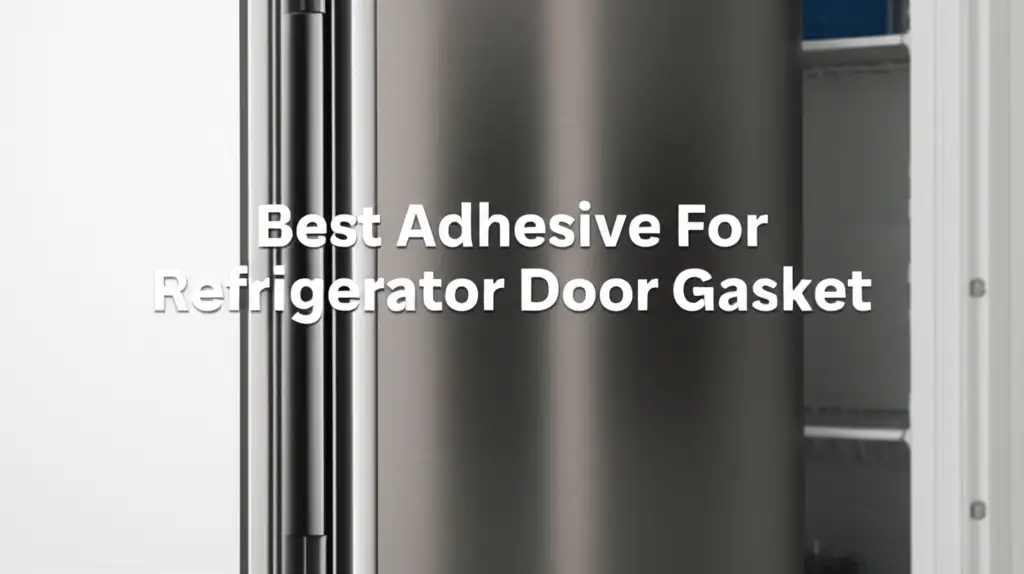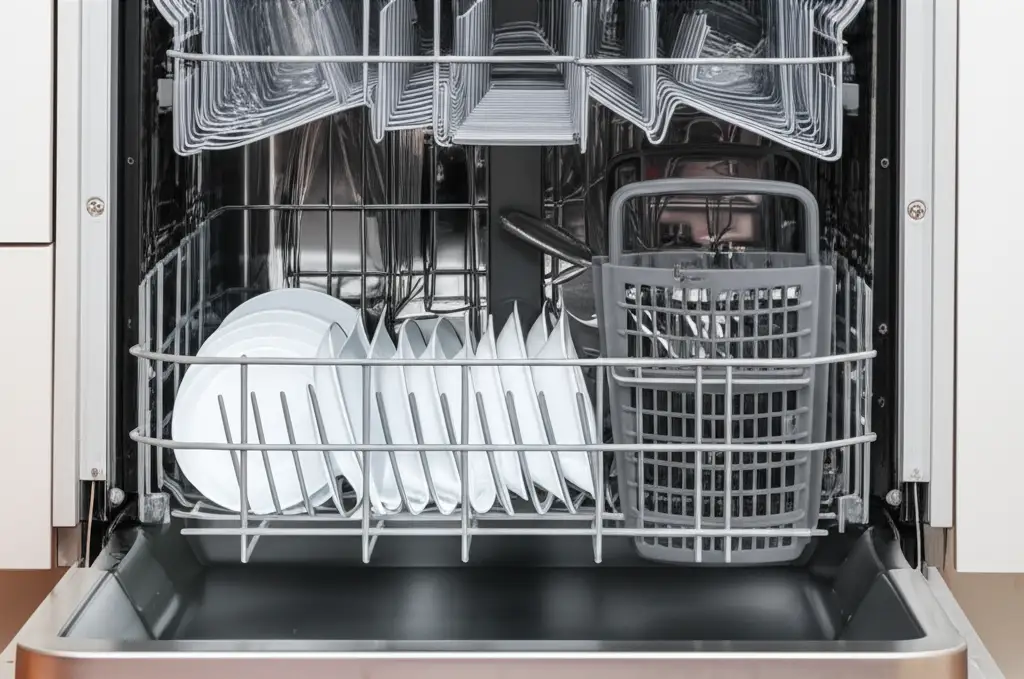· Mason Everett · Home Appliance Repair · 10 min read
Best Adhesive For Refrigerator Door Gasket

Best Adhesive For Refrigerator Door Gasket
Ever feel a strange draft when you stand near your refrigerator? Maybe your food seems to spoil faster, or your energy bills are surprisingly high. The culprit often is a faulty refrigerator door gasket. This crucial seal keeps cold air inside your appliance and warm air out. When it fails, your refrigerator works harder, costing you money and risking your food’s freshness.
Many people think a whole new gasket is the only answer. Sometimes, a simple repair with the best adhesive for refrigerator door gasket can solve the problem. Choosing the right adhesive ensures a lasting, effective repair. It helps restore your refrigerator’s efficiency. This article explains how to identify gasket issues, pick the right adhesive, and apply it correctly. You will learn important maintenance tips to keep your gasket in top shape.
Takeaway
- Choose flexible, temperature-resistant adhesives like silicone or neoprene for gasket repair.
- Clean refrigerator door and gasket surfaces thoroughly before applying any adhesive.
- Allow ample curing time for the adhesive to form a strong, lasting bond.
- Regularly clean and inspect your refrigerator gasket to extend its life and maintain efficiency.
Concise Answer
The best adhesive for refrigerator door gasket repair is typically a flexible, temperature-resistant silicone sealant. For sections needing a strong, immediate bond, a neoprene-based contact cement also works well. Both options ensure durability and maintain the crucial airtight seal your refrigerator needs to run efficiently.
Understanding Refrigerator Gaskets and Their Importance
Every refrigerator has a gasket around its door. This rubber or PVC seal creates an airtight barrier. Its main job is to keep the cold air inside the appliance. It also blocks warm air from getting in. This seal is very important for your refrigerator to work correctly.
A healthy gasket saves energy. It prevents your refrigerator from running too much. When the gasket fails, cold air leaks out. Warm air enters. This forces your refrigerator to work harder to maintain its temperature. This extra work leads to higher energy bills. It also makes your food spoil faster.
Common issues with gaskets include cracks, tears, or hardening. The gasket can also become loose or detach from the door. These problems disrupt the seal. A damaged gasket means poor insulation. It compromises food safety. Repairing or replacing a faulty gasket maintains your refrigerator’s efficiency. It helps keep your food fresh for longer.
Exploring Common Adhesive Types for Gasket Repair
When you need to repair a refrigerator gasket, the choice of adhesive matters. Not all glues are suitable for this job. You need an adhesive that stays flexible. It must withstand temperature changes. It also needs to resist moisture. Standard super glues or hard epoxies are often a bad choice. They become rigid when dry. This rigidity prevents the gasket from sealing properly. It can also cause the gasket to crack or break again quickly.
You should look for adhesives designed for rubber or vinyl materials. They also need to handle cold temperatures. Adhesives like silicone sealants, contact cements, and some weatherstripping glues are good options. Each type offers different benefits. They also have different application methods. Understanding these differences helps you pick the right product. This choice leads to a successful and lasting repair.
Silicone Sealant: A Flexible and Durable Solution
Silicone sealant is a popular choice for refrigerator gasket repair. It offers excellent flexibility. This flexibility is important for the gasket’s movement. It allows the door to open and close smoothly. Silicone can withstand a wide range of temperatures. It performs well in the cold environment of a refrigerator. This adhesive forms a strong, lasting bond. It also resists moisture and mold growth. This is a big plus for areas around food.
Applying silicone sealant requires patience. You typically apply a thin, even bead to the loose section of the gasket. You then press it firmly into place. Silicone sealants often need time to cure. This curing process can take several hours. Some types require a full 24 hours. Always check the product instructions for exact curing times. This waiting period ensures the adhesive forms its strongest bond. Silicone is ideal for minor tears, small gaps, or reattaching short loose sections.
Contact Cement and Neoprene Adhesives: Strong Bonding Options
Contact cement and neoprene-based adhesives offer strong bonding solutions for refrigerator gaskets. These adhesives create an immediate and powerful bond. Neoprene is a synthetic rubber. It provides excellent adhesion to rubber, metal, and plastic surfaces. Many contact cements use neoprene as their base. They are very effective when you need a firm, permanent attachment.
These adhesives are especially useful when a large section of the gasket has come loose. You apply the adhesive to both surfaces: the gasket and the refrigerator door frame. You let both surfaces dry until they are tacky. Then, you carefully press them together. The bond forms almost instantly. This means you must align the gasket precisely before contact.
A key difference from silicone is their reduced flexibility once cured. While they offer a very strong bond, they might not be as pliable as silicone sealants. They also emit strong fumes during application. Ensure good ventilation when using them. Contact cement is best for sections where a very strong, less flexible bond is acceptable.
Preparing the Refrigerator Door and Gasket for Adhesion
Proper surface preparation is crucial for any adhesive to work well. This step ensures a strong, lasting bond for your refrigerator gasket. Start by turning off and unplugging your refrigerator for safety. Then, thoroughly clean the area where the gasket needs reattachment. This means removing all old adhesive, dirt, grease, and grime.
Use a mild soap and warm water solution. A clean cloth helps wipe down the gasket and the door frame. After washing, rinse the area with clean water. Then, wipe it down with rubbing alcohol. Alcohol removes any remaining soap residue or oils. It helps the surface dry completely. Ensure both the gasket and the door frame are absolutely dry before applying adhesive. Moisture will prevent the adhesive from bonding correctly. A clean, dry surface allows the adhesive to grip firmly. This thorough cleaning process is key for a successful repair. For broader cleaning tips, you can review how to clean the refrigerator.
Step-by-Step Adhesive Application for Gasket Repair
Applying adhesive to your refrigerator gasket requires careful steps. First, gather your materials: the chosen adhesive, clean cloths, gloves, and painter’s tape. Ensure your work area has good ventilation. Start by cleaning the gasket and door frame as described previously. This ensures maximum adhesion.
For silicone sealant, apply a small, continuous bead along the loose section of the gasket. Do not use too much. Too much adhesive creates a mess. Press the gasket firmly into place along the door frame. For contact cement, apply a thin, even coat to both the gasket and the door frame. Let both surfaces dry until they feel tacky to the touch. This usually takes 5-15 minutes.
Once tacky, carefully align the gasket and press it firmly onto the door frame. Contact cement bonds instantly, so precision is important. For both adhesives, use painter’s tape to hold the gasket in place. This tape provides gentle pressure while the adhesive cures. Leave the tape on for the full curing time recommended by the adhesive manufacturer. Avoid closing the refrigerator door fully until the adhesive has completely set. This prevents the gasket from sticking to the refrigerator body. After curing, remove the tape and test the seal with a dollar bill. It should feel slight resistance when you pull it out.
Maintaining Your Refrigerator Gasket for Lasting Performance
After you repair your refrigerator gasket, proper maintenance helps it last longer. Regular cleaning is simple but very effective. Food crumbs, spills, and general grime can build up on the gasket. This buildup makes the gasket sticky. It can also cause it to lose its flexibility. Use a damp cloth with mild soap and water to wipe down the gasket regularly. Then, dry it completely. This simple step prevents dirt from hardening the rubber.
You should also inspect your gasket often. Look for small cracks, tears, or signs of detachment. Catching minor issues early makes repairs easier. Some experts suggest applying a thin layer of petroleum jelly to the gasket. This can keep the rubber supple and prevent cracking. Always check your refrigerator’s manual before doing this. Avoid harsh chemical cleaners. These can degrade the rubber material over time. Finally, avoid slamming your refrigerator door. Gentle closing reduces stress on the gasket. These simple habits extend your gasket’s life and keep your refrigerator running efficiently.
FAQ Section
Q: Can I use super glue for my refrigerator gasket? A: No, super glue is not suitable for refrigerator gaskets. Super glue dries very rigid and brittle. Refrigerator gaskets need flexibility to create a proper seal. A rigid bond will crack and fail quickly with the door’s movement. You need an adhesive that remains flexible, like silicone.
Q: How do I know if my refrigerator gasket needs repair or replacement? A: You can perform a “dollar bill test.” Close the refrigerator door on a dollar bill. If you can easily pull the bill out, the gasket has a poor seal. Visually inspect for cracks, tears, or sections that do not seal tightly. Small detached sections or minor tears often allow for repair. Large, widespread damage means you likely need a full replacement.
Q: How long does refrigerator gasket adhesive take to dry? A: The drying time for refrigerator gasket adhesive varies by product type. Silicone sealants often require 2-24 hours for full cure, depending on humidity and thickness. Contact cements dry to a tacky state in 5-15 minutes, allowing immediate bonding, but achieve full strength over 24-48 hours. Always follow the specific instructions on your adhesive’s packaging.
Q: Can I repair a torn refrigerator gasket? A: Yes, you can often repair small tears in a refrigerator gasket. Use a flexible adhesive like silicone sealant. Apply a small amount to the tear, then gently press the edges together. Secure with painter’s tape until the adhesive cures completely. This repair can restore the seal and extend the gasket’s life.
Q: What if the gasket keeps detaching after applying adhesive? A: If your gasket repeatedly detaches, the surface preparation might be insufficient. Ensure both surfaces are completely clean and dry before applying adhesive. Also, check if the gasket itself is too old or damaged to hold a bond. Sometimes, a very worn or stiff gasket needs a full replacement, as adhesive cannot fix the material’s degradation.
Conclusion
A properly sealed refrigerator door gasket is vital for your appliance’s performance. It saves energy, keeps food fresh, and reduces strain on your refrigerator’s compressor. Choosing the best adhesive for refrigerator door gasket repair is a simple, cost-effective way to fix common issues. We discussed why flexible options like silicone sealant are often preferred. We also covered when stronger, immediate bonds from contact cement are beneficial.
Remember, proper surface preparation is the most important step. Clean both the gasket and the door frame thoroughly before applying any adhesive. Follow the application instructions carefully. Allow the adhesive enough time to cure fully. This patience ensures a strong, lasting bond. By taking these steps, you can effectively repair your gasket. You will maintain your refrigerator’s efficiency. This saves you money on energy bills and keeps your food safely chilled. Do not let a minor gasket issue become a major problem for your home.
- refrigerator door gasket adhesive
- gasket repair
- appliance repair
- silicone sealant
- contact cement
- refrigerator seal





